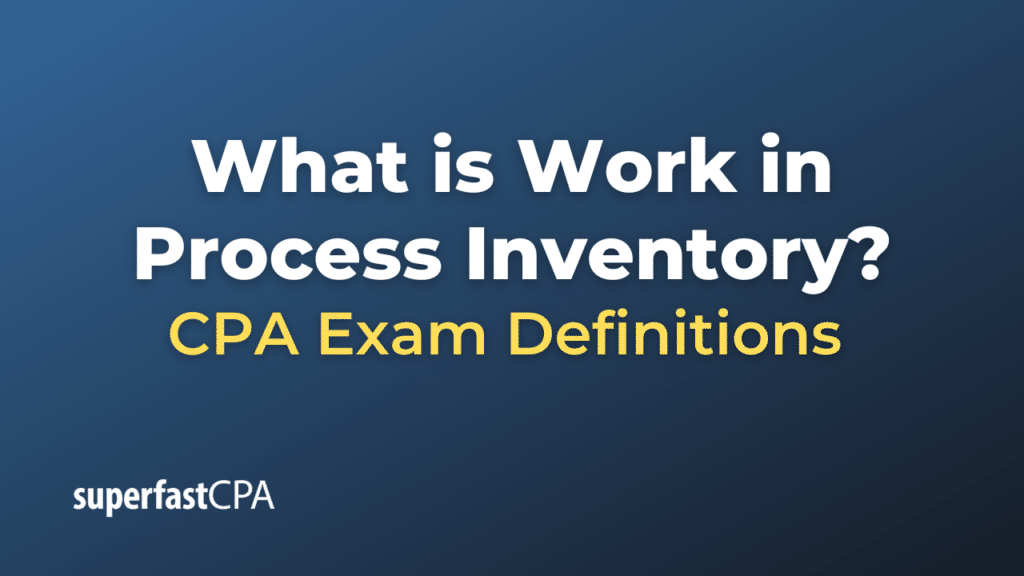Work in Process Inventory
Work in Process (WIP) Inventory refers to the goods that are in various stages of the production process but are not yet completed. These goods are considered an asset on a company’s balance sheet. The value of WIP Inventory includes the costs of raw materials, labor, and overhead that have been incurred from the start of the production process until the point at which the goods are still in process.
WIP Inventory is a crucial component of production and financial accounting for companies involved in manufacturing or producing physical goods. It helps in providing insights into the efficiency of the production process and the effective utilization of resources. Management often monitors levels of WIP Inventory to ensure they align with production schedules and demand forecasts.
Components of WIP Inventory:
- Material Costs: The cost of raw materials that have been used in the unfinished goods.
- Labor Costs: The labor costs that have been incurred to bring the product to its current state in the production process.
- Overhead Costs: The indirect manufacturing costs, such as utilities, rent, and depreciation, that are allocated to the unfinished goods.
Importance:
- Cash Flow: High levels of WIP Inventory can tie up capital, affecting cash flow.
- Efficiency: Monitoring WIP Inventory helps companies identify bottlenecks and inefficiencies in the production process.
- Valuation: Accurate accounting of WIP is essential for correct financial statements. It impacts the balance sheet, cost of goods sold (COGS), and profit and loss statements.
Example of Work in Process Inventory
Let’s delve into a specific example to illustrate the concept of Work in Process (WIP) Inventory.
BakeMaster Inc. specializes in manufacturing high-end ovens for commercial bakeries. The company has a three-stage manufacturing process for each oven:
- Stage 1: Assembly of the metal frame and installation of gas lines
- Stage 2: Electrical wiring and control panel installation
- Stage 3: Painting and quality control
Costs:
- Stage 1: Material cost is $500, labor cost is $100, and overhead is $50.
- Stage 2: Material cost is $300, labor cost is $100, and overhead is $50.
- Stage 3: Material cost is $100 (mostly paint), labor cost is $50, and overhead is $25.
Scenario:
At the end of an accounting period, BakeMaster Inc. has:
- 5 ovens in Stage 1
- 3 ovens in Stage 2
- 2 ovens in Stage 3
Calculation of WIP Inventory:
- For Stage 1 Ovens:
- Cost per oven in Stage 1 = $500 (material) + $100 (labor) + $50 (overhead) = $650
- Total cost for 5 ovens in Stage 1 = 5 x $650 = $3,250
- For Stage 2 Ovens:
- Cost per oven up to Stage 2 = $500 (material for Stage 1) + $300 (material for Stage 2) + $100 (labor for Stage 1) + $100 (labor for Stage 2) + $50 (overhead for Stage 1) + $50 (overhead for Stage 2) = $1,100
- Total cost for 3 ovens in Stage 2 = 3 x $1,100 = $3,300
- For Stage 3 Ovens:
- Cost per oven up to Stage 3 = $500 (material for Stage 1) + $300 (material for Stage 2) + $100 (material for Stage 3) + $100 (labor for Stage 1) + $100 (labor for Stage 2) + $50 (labor for Stage 3) + $50 (overhead for Stage 1) + $50 (overhead for Stage 2) + $25 (overhead for Stage 3) = $1,325
- Total cost for 2 ovens in Stage 3 = 2 x $1,325 = $2,650
- Total WIP Inventory:
- WIP Inventory = Cost of ovens in Stage 1 + Cost of ovens in Stage 2 + Cost of ovens in Stage 3
- WIP Inventory = $3,250 (Stage 1) + $3,300 (Stage 2) + $2,650 (Stage 3) = $9,200
At the end of the accounting period, the WIP Inventory for BakeMaster Inc. would be valued at $9,200, which would appear as an asset on the company’s balance sheet. This gives an accurate picture of the capital tied up in production, helping the management make informed decisions.













